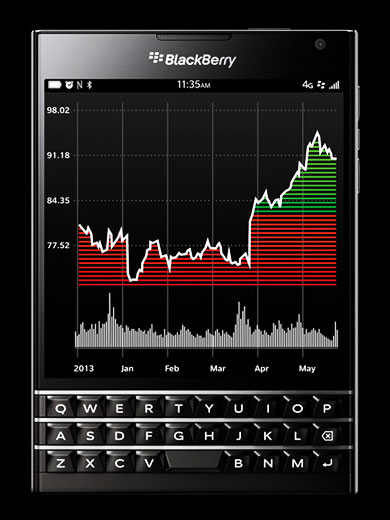BlackBerry on Wednesday officially launched its new square form factor smartphone, the Passport. This new handset has the size and shape of most national passports, which the company dubbed the “international symbol of mobility.”
The Passport is now available for US$599 in an unlocked version, or about $250 with a new contract. AT&T is the first U.S. carrier to offer the handset, which also is now available in the Canadian, French, German and British markets. It should be in more than 30 countries by the end of the year.
The new square phone is not BlackBerry’s only handset news, however. It announced that later this year, it will release the BlackBerry Classic, an updated version of its popular smartphone that features the traditional keyboard, trackpad and physical navigation keys of earlier BlackBerry devices. Clearly, the company is betting on the mantra that everything old is new again.
Passport Prospects
This week, though, is all about the Passport. With its three-row physical QWERTY keyboard, the Passport at first glance may seem like a phone from yesteryear. In fact, it is a mix of retro design elements and the latest technology. The handset weighs 196 grams and is just 9.3mm thick.
It offers a 4.5-inch in-cell IPS LCD Touch Display with 1440 x 1440 resolution. It is powered by a 2.2-GHz Quad-Core Qualcomm Snapdragon 801 processor, and it offers 3 GB of RAM and 32 GB of Flash memory. It supports a swappable microSD card up to 128 GB.
It has both a 13-megapixel rear-facing camera and a 2-megapixel front-facing camera, and each supports image and video stabilization and HD video recording. It has 30 hours of battery life with mixed use, the company claimed.
The Passport’s standout features are its physical keyboard and the nearly square screen that offers a pixel density of 453ppi. It can display 60 characters per line.

Early reviewers of the device have given kudos to the large screen and physical keyboard but called out the seeming awkward form factor that makes it hard to use with one hand.
“It’s an odd shape that doesn’t seem to fit today’s market either,” telecommunication industry analyst Jeff Kagan told TechNewsWorld. “I had always hoped that BlackBerry would simply modernize their once popular Torch or Bold devices. They would have had more luck with that.”
BlackBerry Goes Big
While the form factor of BlackBerry’s Passport may not be winning hearts and minds, it is not the only device that seemingly has been supersized. Apple’s new iPhone 6 Plus, which was announced earlier this month, also played into the bigger is better market.
“There is no question in my mind or in the research that we’ve seen that there is huge demand for a larger screen on the handset,” said Ryan Reith, program manager for mobile devices at IDC. “A big reason that the North American market hasn’t moved to larger screens is really because people are hooked on the iPhone.”
Internationally, larger devices are becoming increasingly popular, especially as users are doing more than chatting on the mobile phone.
“Most of us aren’t talking on the phones,” Reith told TechNewsWorld.
“These devices are not really phones first; users are sending more content through text and email than making phone calls. A bigger screen helps,” he said.
“When the original Galaxy Note handset came out, people said it was absurd because it was too big,” he noted. “However, it would still fit in your hand — and it may look weird at first, but it turned out to be manageable.”
Productive Phablet
With its large screen, the BlackBerry Passport could fit into the phablet category and be a real productivity device rather than an entertainment device.
“The phablet form factor makes it possible to do work on it, in the classic document-centric sense,” Steve Blum, principal analyst at Tellus Venture Associates, told TechNewsWorld.
“The physical keyboard will suit some people better than virtual ones, even though the layout is less than intuitive,” he said. “And it’s rugged, which makes it attractive to a wide range of users, particularly people who work on their feet or outside — so long as they have a big pocket to put it in.”
Keying Back In
Just as demand has grown for bigger screens, there has been some demand for physical keyboards. BlackBerry could key into a niche market — those who prefer the tactile typing experience.
“It was clear that Apple wouldn’t do a keyboard, but this was an opportunity that Android had but also opted against,” noted IDC’s Reith. “While the youngest generation may not want a keyboard, there are many other users that started with BlackBerry and like the physical keyboard.”
However, even with this niche demand, it is unlikely that the Passport alone will return BlackBerry to its former glory.
“The Passport does not seem to be receiving many positive comments, and it may not help BlackBerry ride high once again,” observed Kagan.
“Those days are over. The real question is will the Passport capture enough market share to help BlackBerry stay alive,” he added.
“The Blackberry Passport would be a great product if it ran the Android OS. Unfortunately, it runs BlackBerry 10 instead of Android,” said Blum.
“Launching an oddball form factor into a big ecosystem will sometimes produce a hit product,” he noted. “Launching an oddball product into an oddball niche guarantees slow acceptance and low sales figures. Anyone who buys it has to be both comfortable with the size and other physical characteristics and with the Blackberry OS.”





















































